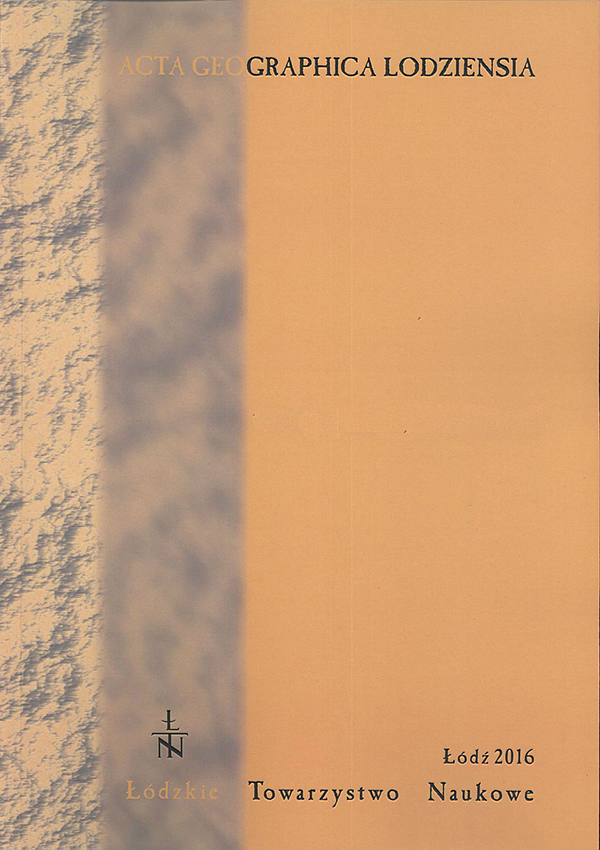Próba rekonstrukcji rozwoju zbiornika akumulacji biogenicznej w Bydlinie (Wyżyna Śląsko-Krakowska)
The tentative reconstruction of evolution of the biogenic accumulation reservoir in Bydlin (Silesian-Cracovian Upland
Author(s): Daniel Okupny, Małgorzata Nita, Marek Kloss, Paweł Aleksandrowicz, Anna Fortuniak, Sławomir ŻurekSubject(s): Geography, Regional studies, Environmental Geography
Published by: Łódzkie Towarzystwo Naukowe
Keywords: biogenic sediments; geoche4mistry; palaeobotanical analyses; malacological analysis; Silesian-Cracovian Upland
Summary/Abstract: The aim of this paper is to describe the sediments infilling the mire in the karst paleopolja nearBydlin, in the Silesian-Cracovian Upland (Fig. 1A, B). The study involves the description of thelithogeochemical and botanical composition of the deposit formations, as well as the geological structureof the valley constituting a part of the Tarnówka river valley, where the mire is located. Based ona dense drillings network, the morphology of the mire basin bottom and the types and thickness ofgyttja and peat sediments were examined (Fig. 1C). The sedimentary sequence in the studied peatbogis highly differentiated, there are: brown moss peat, sedge-moss peat, tall-sedge peat and lake deposits,among them mainly calcareous gyttja, clay-calcareous gyttja and lacustrine chalk. Limnic depositsevidence lake phases in the sedimentary basins in the western and southern part of the mire.This paper presents the results of lithogeochemical analyses of biogenic deposits in three cores(Fig. 2). The thickness of organogenic sediments varied from 3,40 m (B-1 core), 4,0 m (B-2 core) to4,2 m (K-2 core). Five hundred eighty two sediment samples were subjected to the following analyses:loss on ignition at 550ºC (OM), amount of calcium carbonate by means of the Scheibler volumetricmethod (CaCO3) and content of biogenic and terrigenous silica (SiO2biog and SiO2ter). The malacological analysis was performed based on core sections representing 0,10–0,20 m thick intervals, depending on the deposit form. A total of 15 samples were included in the malacological analysis inthe B-2 core (Fig. 3). 26 samples (each 1 cm3 in volume) from a B-1 core were examined by means ofpollen analysis. In sediments lying at a depth of 3,40–3,20 m, 1,21–1,08 m and 0,87–0 m, pollen wasnot recorded or its frequency was extremely low. A pollen diagram was drawn using the POLPALcomputer program (Fig. 4). The calculation was based on the total of tree and bushes (AP) and as wellas herbaceous plant and draft shrubs (NAP). Samples (about 20 cm3) for a macrofossils analysis weretaken every 2–12 cm from B-2 core (Fig. 5). The material was rinsed with water onto sieves with meshsize of 0.25 and 0.5 mm. The residue was identified under a stereoscopic microscope at a magnificationof 10-100x. In total, 33 samples were analysed using the accessible botanical keys and atlases.The geochemical analysis reveals a high rate of hydrological and geomorphological changes in the reservoir and its catchment. The pollen analysis of the lake sediments from core B-1 suggests puts theage of the lake at the beginning of the Preboreal. Calcareous gyttja and lacustrine chalk with a very highcalcium carbonate content (almost 100%) were deposited. Sediments of the bottom parts of the studiedcores are characterized by high content of terrigenous silica, which suggests higher rates of mechanicaldenudation and erosion rate of the catchment. The malacofauna is marked by a fairly stable compositionand structure. The analysed material in the lake sediments contained specimens of aquatic species typicalof seasonal water bodies (ecological group T) and molluscs of permanent water bodies (ecological groupP). Dominant among the aquatic species is the snail Valvata piscinalis, which occurs in all samples andsometimes reaches large numbers. The second significant component of the assemblage is Sphaeriumcorneum. The accumulation of peat formations in the Holocene was not continuous. The bottom of thepeat deposit contains mainly Warnstorfia exannulata, Pseudocalliergon trifarium and Menyanthes trifoliate,and the upper part is composed of sedge-moss and tall-sedge peats, which suggests stable groundalimentation.
Journal: Acta Geographica Lodziensia
- Issue Year: 2016
- Issue No: 105
- Page Range: 55-68
- Page Count: 14
- Language: Polish

